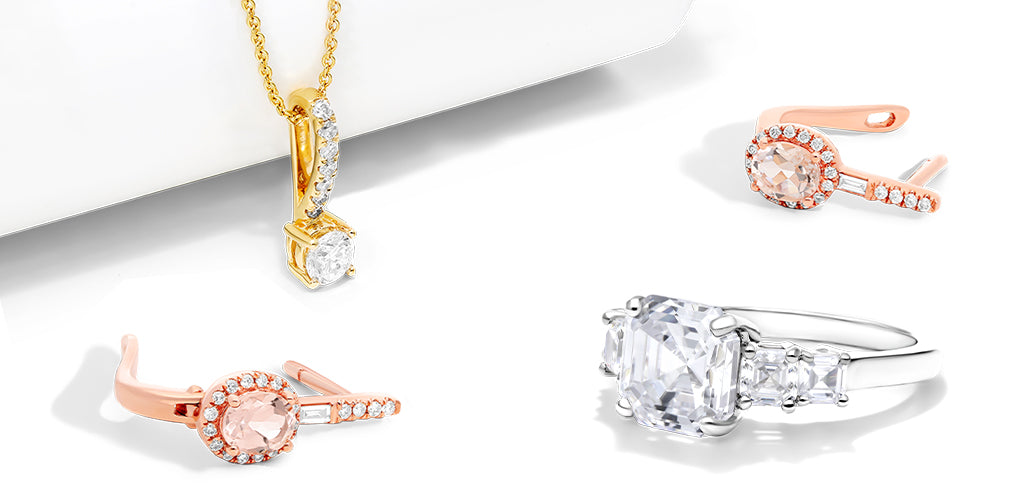When it comes to choosing jewelry, the material is one of the most important factors to consider. Gold, silver, and platinum are the three most popular precious metals used in jewelry making, each offering unique properties, aesthetics, and benefits.
Whether you're shopping for an engagement ring, a necklace, or a pair of earrings, understanding the differences between these materials can help you make an informed decision. This comprehensive guide will compare gold, silver, and platinum in terms of their properties, pros and cons, and suitability for different types of jewelry.
- Part 1: Gold: The Timeless Classic
- Part 2: Silver: The Affordable Elegance
- Part 3: Platinum: The Durable Luxury
- Part 4: Comparing Gold, Silver, and Platinum
- Part 5: Choosing the Right Metal for Your Jewelry
- Part 6: Caring for Your Jewelry
Part 1. Gold: The Timeless Classic
1. Properties of Gold
Gold is a precious metal known for its luster, malleability, and resistance to tarnish. It is often alloyed with other metals to increase its durability and strength. The purity of gold is measured in karats (K), with 24K goldbeing the purest form.
1.1 Types of Gold
- Yellow Gold: This is the natural color of gold and is the most traditional choice for jewelry. It is often alloyed with copper and zinc to enhance its strength.
- White Gold: White gold is created by alloying gold with white metals such a palladium or nickel and is often rhodium-plated to give it a bright, silvery appearance.
- Rose Gold: Rose gold is made by alloying gold with copper, giving it a pinkish hue. It is known for its warm and romantic appearance.
2. Pros of Gold
- Timeless Appeal: Gold has been used in jewelry for thousands of years and continues to be a symbol of wealth and luxury.
- Versatility: Gold is available in various colors (yellow, white, and rose), making it versatile and suitable for a wide range of styles.
- Malleability: Gold's malleability makes it easy to work with, allowing for intricate designs and detailed craftsmanship.
3. Cons of Gold
- Softness: Pure gold (24K) is soft and can be easily scratched or dented. Alloying it with other metals increases its durability but reduces its purity.
- Maintenance: White gold requires periodic rhodium plating to maintain its bright appearance, and all gold jewelry needs regular cleaning to retain its luster.
4. Suitability for Jewelry
Gold is suitable for a wide range of jewelry, including engagement rings, wedding bands, necklaces, bracelets, and earrings. Its timeless appeal and versatility make it a popular choice for both everyday wear and special occasions.
Part 2. Silver: The Affordable Elegance
1. Properties of Silver
Silver is a precious metal known for its brilliant luster, affordability, and excellent conductivity. It is often alloyed with copper to create sterling silver, which is 92.5% pure silver and 7.5% copper.
2. Pros of Silver
- Affordability: Silver is more affordable than gold and platinum, making it an accessible option for those on a budget.
- Luster: Silver has a bright, reflective luster that gives it a stunning appearance.
- Versatility: Silver's neutral color makes it versatile and easy to pair with various outfits and other jewelry.
3. Cons of Silver
- Tarnish: Silver is prone to tarnishing when exposed to air and moisture, requiring regular cleaning and maintenance.
- Softness: While sterling silver is more durable than pure silver, it is still softer than gold and platinum, making it more susceptible to scratches and dents.
4. Suitability for Jewelry
Silver is suitable for a wide range of jewelry, including rings, necklaces, bracelets, earrings, and cufflinks. Its affordability and versatility make it a popular choice for everyday wear and casual occasions.
Part 3. Platinum: The Durable Luxury
1. Properties of Platinum
Platinum is a precious metal known for its durability, density, and resistance to tarnish. It is 95% pure in jewelry, making it one of the purest and most hypoallergenic metals available.
2. Pros of Platinum
- Durability: Platinum is extremely durable and resistant to wear and tear, making it an excellent choice for everyday jewelry.
- Hypoallergenic: Platinum is hypoallergenic, making it a safe choice for those with sensitive skin.
- Luster: Platinum has a natural white luster that does not fade over time, maintaining its beautiful appearance without the need for rhodium plating.
3. Cons of Platinum
- Cost: Platinum is more expensive than gold and silver, making it a luxury option.
- Weight: Platinum is denser and heavier than gold and silver, which may be less comfortable for some people to wear.
4. Suitability for Jewelry
Platinum is particularly suitable for engagement rings, wedding bands, and other pieces that are worn daily and require durability. Its hypoallergenic properties and natural luster make it a premium choice for high-end jewelry.
Part 4. Comparing Gold, Silver, and Platinum
1. Durability
- Gold: Gold is malleable and can be scratched or dented more easily than platinum. However, alloyed gold (e.g., 14K or 18K) is more durable than pure gold.
- Silver: Silver is softer than both gold and platinum and is more prone to scratches and tarnish.
- Platinum: Platinum is the most durable of the three metals, making it highly resistant to wear and tear.
2. Maintenance
- Gold: Gold requires regular cleaning to maintain its luster. White gold needs periodic rhodium plating to retain its bright appearance.
- Silver: Silver requires frequent cleaning to prevent tarnish and maintain its shine.
- Platinum: Platinum requires minimal maintenance and does not need rhodium plating. Its natural luster remains intact over time.
3. Cost
- Gold: Gold is more expensive than silver but less expensive than platinum. The price varies depending on the karat and type of gold.
- Silver: Silver is the most affordable of the three metals, making it an accessible option for many people.
- Platinum: Platinum is the most expensive of the three metals, reflecting its durability, purity, and luxury status.
4. Hypoallergenic Properties
- Gold: Gold is generally hypoallergenic, but some people may have allergic reactions to the alloys used in gold jewelry.
- Silver: Silver is hypoallergenic for most people, but some may experience allergic reactions to the copper in sterling silver.
- Platinum: Platinum is highly hypoallergenic, making it a safe choice for those with sensitive skin.
5. Aesthetic Appeal
- Gold: Gold offers a warm, luxurious appearance and is available in various colors (yellow, white, and rose).
- Silver: Silver has a bright, reflective luster and a neutral color that complements various styles.
- Platinum: Platinum has a natural white luster that is timeless and elegant, making it a premium choice for high-end jewelry.
Part 5: Choosing the Right Metal for Your Jewelry
1. Consider Your Budget
Your budget will play a significant role in determining which metal is right for you. If you're looking for an affordable option, silver may be the best choice. If you're willing to invest in a luxury piece, platinum or gold may be more suitable.
2. Think About Durability
Consider how durable you need your jewelry to be. If you're looking for a piece that will withstand daily wear, platinum is the most durable option. If you prefer a softer, more malleable metal, gold may be a better choice.
3. Evaluate Maintenance Requirements
Think about how much maintenance you're willing to commit to. If you prefer a low-maintenance option, platinum is the best choice. If you don't mind regular cleaning and maintenance, gold and silver are also great options.
4. Consider Your Skin Sensitivity
If you have sensitive skin, platinumis the most hypoallergenic option. Gold is also generally hypoallergenic, but be mindful of the alloys used. Silver is hypoallergenic for most people, but some may react to the copper in sterling silver.
5. Match Your Style
Consider your personal style and the aesthetic you're looking for. If you prefer a warm, luxurious look, gold may be the best choice. If you prefer a bright, reflective luster, silver is a great option. If you want a timeless, elegant appearance, platinum is the way to go.
Part 6: Caring for Your Jewelry
1. Gold
- Cleaning: Clean gold jewelry with a mild soap and warm water solution. Use a soft brush to remove dirt and debris.
- Storage: Store gold jewelry in a soft, padded jewelry box to prevent scratches. Keep pieces separated to avoid them rubbing against each other.
- Maintenance: Have gold jewelry inspected by a professional jeweler at least once a year to check for loose settings and signs of wear.
2. Silver
- Cleaning: Clean silver jewelry with a silver polishing cloth or a mild soap and warm water solution. Avoid using harsh chemicals.
- Storage: Store silver jewelry in an anti-tarnish bag or jewelry box with anti-tarnish strips. Keep pieces separated to prevent tarnish.
- Maintenance: Polish silver jewelry regularly to maintain its shine. Have it inspected by a professional jeweler at least once a year.
3. Platinum
- Cleaning: Clean platinum jewelry with a mild soap and warm water solution. Use a soft brush to remove dirt and debris.
- Storage: Store platinum jewelry in a soft, padded jewelry box to prevent scratches. Keep pieces separated to avoid them rubbing against each other.
- Maintenance: Have platinum jewelry inspected by a professional jeweler at least once a year to check for loose settings and signs of wear.
Conclusion
Choosing the right material for your jewelry is a personal decision that depends on your budget, lifestyle, and style preferences Gold, silver, and platinum each offer unique benefits and aesthetic appeal, making them suitable for different types of jewelry and occasions.
By understanding the properties, pros and cons, and maintenance requirements of each metal, you can make an informed decision that aligns with your needs and preferences. Whether you're drawn to the timeless elegance of gold, the affordable beauty of silver, or the durable luxury of platinum, there's a metal out there that will perfectly complement your style and enhance your jewelry collection.
So, take the time to explore your options, consider your priorities, and choose the metal that resonates with you. With the right care and attention, your jewelry will remain beautiful and valuable for years to come.

